The painter Yitzhok Loiza Grossberg is way up there on my list of favorite artist. Never heard of him? You probably know him better as Larry Rivers. Ever come across the work of the artist Judy Cohen? Perhaps you know her as Judy Chicago. And the reason I mention Chicago is that she currently has her iconic 1973 “Through the Flower” painting hanging in the Platt/Borstein Galleries at American Jewish University as part of the Pacific Standard Time celebration under way in galleries and museums throughout Los Angeles.
Fortunately for me, the galleries two curators, Elizabeth Bloom (also an artist) and Elaine Levin (an art historian), invited me to a sneak pre-opening preview of their exhibit. Bloom and Levin selected no less than eighteen Los Angeles Jewish artists active between 1945 and 1980 to hang in the show. The result is a smorgasbord opportunity to see the influence and contributions that these artists made towards turning LA from an art backwater into the significant center it now is.
To me the exhibit was like an archeological site roughly five-decades/strata deep of LA’s artistic products; a healthy panoply of known and lesser-known artists. Embedded in these layers are several works representing artistic movement s that originated in L.A. For example, there are two striking untitled 1971 screen prints from Lorser Feitelson clearly indicating the birth of color field, hard-edge painting. Feitelson, who was born in 1898, saw plenty of art movements before setting foot in Los Angeles. Once here, he founded the “Post-Surrealism” movement, along with his painter wife Helen Lundeberg. If that wasn’t enough, he also taught at Chouinard and Art Center, sites where I took many an art class. At one point, he was a director of the Los Angeles Art Association, currently run by the capable Peter May, an organization of which I’ve always been proud to be a member.
Besides hard edge, there came the innovative conceptual work from Pomona and assemblages such as Ed Kienholz. But LA also put a new form of ceramics on the map, essentially from Peter Voulkos at Otis. His star pupil was Michael Frimkess and the show displays two stunning vessels by Frimkess. Particularly brilliant is his 1974 vessel entitled, “Jumpin’ at the Moon Lodge.” Full of his cartoon whimsical figures Frimkess’ work is known for seamlessly organized decorative patterns on oriental shaped vessels.
In the middle of the gallery stand three ceramic room miniatures: a bathroom, a café, and a bedroom, all by the artist David Furman. At first glance it’s easy to dismiss these ceramic pieces as simply gimmicky miniatures done to be different. But seconds after getting up close, one is so completely absorbed into these works that the former notion totally dissolves. Each miniature room, devoid of people, contains a single white dog (the same dog in each room). In the bathroom the dog is perched looking into the bathtub, at the café the dog stands on one of the booth seats, and in the bedroom the dog is lying on the bed. The dog turns out to be the artist’s late pet “Molly.” With great simplicity and lack of pretension, Furman manages to visually transfer his deep emotions for Molly to the viewer and is truly the show’s unexpected tour de force.
Also historically interesting are the several oil paintings from June Wayne, founder of the Tamarind Lithography Workshop in Hollywood, as well as two architectural photographs by Julius Shulman, the photographer who made his métier synonymous with fine art.
Excitement continues with several works from Joyce Treiman, one of the most accomplished figurative artists of this period who, like Alice Neel, stuck to her guns through abstract expressionism. Her 1974 “Study for Thomas Eakins” (she did numerous paintings placing herself in the same scene with an iconic artist of the past) demonstrates her remarkable rendering skills. Also hanging is her 1979 “Rose in the Living Room,” as sensitive as any Bonnard painting.
More outstanding figurative artists abound such as Ruth Rossman, a founding member of the Fine Arts Council of American Jewish University and Ruth Weisberg, who will soon have an exhibit at the Jack Rutberg Gallery. Another figurative artist is Pat Berger who is known for her landscapes but also what I like to call “peoplescapes”. There’s a large 1980 work entitled “Rollar Disco” from her Venice Beach series spotlighting the “me generation,” styled much like a work from the artist D.J.Hall. Another remarkably strong series from Berger, unfortunately not shown in this exhibit, was entitled, “No Place To Go”, a 1980’s study of LA’s homeless.
Additional artists like Baila Goldenthal who was a student of Hans Hoffman; or formidable works by Peter Krasnow line the gallery walls; stunningly crafted aluminum and wood pieces by Max Finkelstein (born in 1915 and still going strong with a twinkle in his eyes when last I saw him). There are works by William Brice, born to Fanny Brice and the gambler Nicky Arnstein, when he worked at Tamarind. Also on display are works from the famous court illustrator David Rose, the early screen prints of Dave Fox, the studies from the muralist Joe Young, and works from Edward Biberman.
The exhibit is bitter sweet when you realize that two-thirds of the exhibiting artists have passed away, some quite recently. But then you realize that irrespective of how the historical dust has settled and will settle in the future, one can irrefutably say that during their lifetime these artists walked their journey well. The exhibit will run to February 5, 2012.

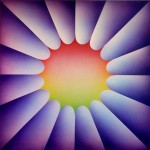
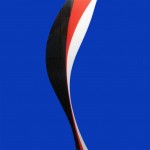


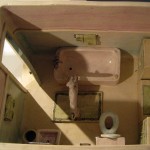
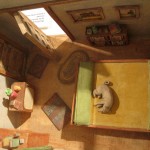
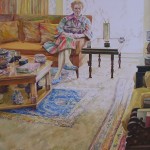
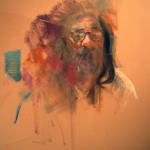

Funny, I thought Judy Chicago’s name was Gerowitz… This sounds like an interesting show, Rene. Also significant is the contribution of Jewish collectors… not to mention dealers, curators, and so on!
Very lovely show, Rene. and a very appropriate write-up.
Your words are truly lyrical. Really enjoy your critiques and now must make time to see the exhibit.
I have always felt influenced by Alice Neel and Joyce Treiman’s works seem equally compelling.
Love David Furman and Max Finkelstein’s works… great exhibit!
Fine description of a beautiful and enlightening show.
Thanks, René, for the thoughtful review. It’s a wonderful show. As webmaster for the Jewish Artists Initiative jaisocal.org I have highlighted your post on our home page — we have four JAI members in the show.